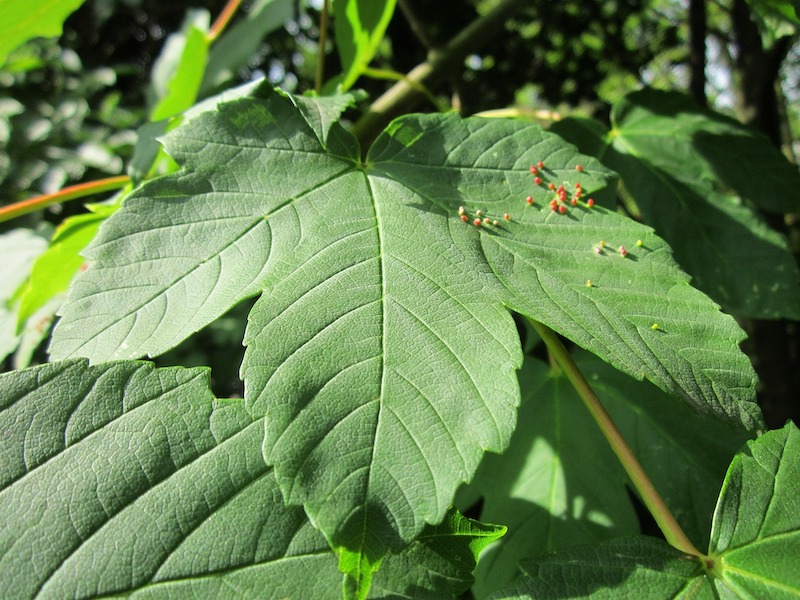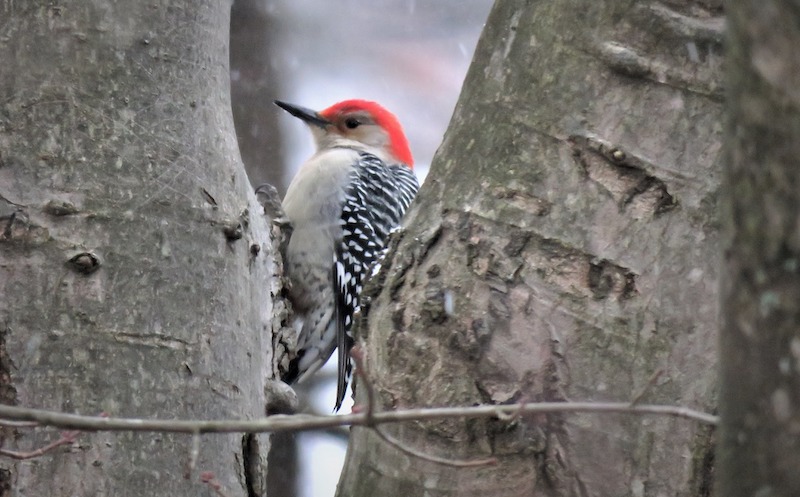Maple trees have several pests that can cause damage and even death if not treated. Insect pests include aphids, beetles, mites, and scales; deer, rabbits, squirrels, mice, and birds can also bother your tree. Many of the insect pests can be controlled with eco-friendly solutions including hand removal, water spray, and insecticidal soap. For critter pests, metal and plastic tree guards often help mitigate any problems and keep your tree healthy.
Common Maple Pests
Aphids
Aphids are tiny, yellow, green, gray, or white bugs that suck sap from plants and trees. These soft-bodied insects can be found on many plants, including maple trees, usually adhering to the undersides of foliage. They pose problems in two ways. First, they damage tree tissue by withdrawing sap. Chlorosis may develop due to the loss of sap from the tree’s leaves. The foliage will appear yellow and may wrinkle as well. Second, the aphids produce honeydew, which attracts an ugly fungus that grows on the tree’s bark and branches. A mature maple can usually recover from a moderate aphid infestation without treatment. A young tree, however, may have more issues if not properly treated.

Treating Aphids on Maple
Maple trees usually recover from moderate aphid infestations. However, if it is a newly planted or young tree, examine its foliage closely to identify any insects. If aphids are spotted, rinse with water and treat with insecticidal soap. Maples are sensitive to horticultural oils such as Neem oil, so refrain from using them. Pruning and removing any damaged/dead foliage and introducing beneficial insects, such as lacewings and ladybugs (ladybird beetles), to young and mature maples are other good ways of controlling the aphid population.
Preventing Aphids on Maple
There are many ways to try and prevent an aphid infestation. Maintaining the maple’s good health is of primary importance. This includes pruning, watering, and fertilizing. You can also spray the foliage with a forceful stream of water to remove aphids.
Adding plants such as catnip, garlic, basil, mint, and marigold close to the maple can repel aphids. Incorporating trap plants such as calendula, nasturtiums, and sunflowers can draw aphids away from plants such as maple, which are more susceptible to their damage when in large numbers. And finally, introducing hungry beneficial bugs such as parasitic wasps, ladybugs, and lacewings should help prevent aphid numbers from rising.
Beetles
Beetles can cause maples significant problems. They commonly target stressed trees and bore into them, damaging external and internal plant tissue. When boring beetles do extensive damage to maple’s bark, creating holes that encircle its trunk, girdling may result and can lead to death.
Some boring beetles, such as the granulate ambrosia beetle, carry a fungus into the tree and leave it when they exit. Still, another type of beetle, the Japanese beetle, is known to eat the foliage of several species of maple. Like a cat devouring a small fish, this beetle voraciously consumes a Japanese maple’s leaf tissue, leaving only the frame of the leaf’s veins behind.
Signs of beetle damage include bark holes, frass, and skeleton-like leaves. A point of interest, however, is that while many species of maple are susceptible to Japanese beetles, one type, red maple, actually repels them.
Treating Beetles on Maple
If your maple suffers from a moderate beetle infestation, first, determine the type of beetle. Second, remove any dead/damaged limbs. Third, remove insects from the tree’s surface by hand or by spraying with water.
If the culprit is the granulate ambrosia beetle, there is no insecticide against it or the fungus it carries into the tree. Remove a tree severely infested with this type of beetle. If the problem is the Japanese beetle, you can try to suffocate the insects using insecticidal soap. While horticultural oils can deter beetles and damage their larvae, do not use them; maple’s sensitivity to them may result in damage. Any tree that beetles severely harm, including girdling, should be removed.
Preventing Beetles on Maple
The primary way to prevent maple from becoming infested with beetles is to encourage its good health; beetles target stressed trees. In particular, ensure that maple receives adequate amounts of water. Secondary prevention methods include planting beetle “trap plants”; adding beneficial insects; and luring birds. Planting “trap plants” such as geraniums, marigolds, and primrose will draw bothersome beetles away from maple. Adding beneficial insects such as nematodes and flower flies and inviting birds by placing attractive bird baths and food sources nearby will help reduce the number of beetles.
Mites
Mites are soft-bodied insects that sometimes damage maple trees. The two worst types are spider mites and Eriophyid mites. Spider mites are arachnids that suck plant juices from the leaves. You can identify them by the webs they weave and the discoloration of leaves they cause. Eriophyid mites produce bumps, called galls, on the undersides of foliage; they mar maple’s otherwise gorgeous leaves. However, while the spots look unattractive, they do not harm the tree’s health.

Treating Mites on Maple
First, prune damaged/dead foliage. Then, spray with water to remove as many bugs as possible. In the case of spider mites, you can treat them with insecticidal soap. Note, however, that Japanese maples are sometimes sensitive to these products. Most maple species are sensitive to horticultural oils, so avoid using them to prevent unnecessary damage.
Preventing Mites on Maple
To prevent a mite infestation, ensure that the maple has good health and is not suffering from dehydration. Also, you can plant mite-repellent plants such as basil, garlic, and onion in maple’s vicinity along with “trap plants” such as marigolds and chrysanthemums a little farther away.
Scales
Scales are gray, white, or brown soft-bodied insects that target stressed plants. They are covered with a wax-like substance that can be soft or hard, and they suck juices from plant tissue. These insects produce honeydew, which attracts fungus. The fungus can further stress the tree and kill its foliage.
Treating Scales on Maple
Scales infest stressed plants first. As a result, make sure that maple is pruned, watered, and fertilized regularly. However, after observing a scale infestation, do not over-fertilize. Well-fertilized plant tissue is desirable to hungry insects such as scale and may encourage them to increase in numbers. First, remove any dead/damaged limbs and leaves. Next, attempt to remove scales with a forceful water spray. If the infestation is severe, you can treat it with horticultural oil or remove the tree. Maples are sensitive to horticultural oil, but you may choose to use it as a last-ditch effort before removing the tree.
Preventing Scales on Maple
Maintain maple’s good health to prevent a scales infestation. Prune, water, and fertilize maple regularly. Other natural methods of preventing these bugs include introducing beneficial insects such as ladybugs (lady beetles) and parasitic wasps.
Critters
Animals, including deer, rabbits, squirrels, mice, and birds, can damage maple trees. They eat its foliage, bark, twigs, buds, flowers, and sometimes the insects lurking inside it. Damage to bark is one of the more severe problems these critters can cause. If deer rubbings or other holes caused by birds, rabbits, or squirrels encircle the tree’s trunk, causing girdling, the tree may ultimately die. Younger maple trees are more susceptible to critter damage and may not tolerate the stress well while trying to establish their roots.

Treating Critters on Maple
When dealing with critters such as deer, squirrels, rabbits, mice, and birds, an ounce of prevention is worth a pound of cure! In a worst-case scenario, if any of these critters destroy enough bark that the bare space encircles the tree, girdling may result. The tree will need to be removed soon because it will die shortly. In a milder situation, where only small spots of bark have been removed, you can leave the tree alone and wait for it to self-heal. The best treatment for both of these cases is one word: prevention.
Preventing Critters on Maple
To protect the lower six feet of maple’s trunk from deer, rabbits, squirrels, and mice, erect a 6-to-8-foot fence around it or wrap a metallic or plastic tree guard around its trunk. You can also incorporate plant species near maple that repel deer and small mammals. These may include butterfly bush, daffodils, garlic, heather, jalapeno, marigold, mint, rosemary, poppy, and Russian sage. Additionally, you can use predator urine, such as fox urine or pepper sprays. To protect a young maple from extensive damage done by birds, you can hang pie plates in the tree or place a scarecrow somewhere close by.
Maple Tree Pests Chart
|
Pest |
Identifying |
Treating |
|
Aphids |
Tiny, yellow, green, gray, or white bugs |
Rinse with water and treat with insecticidal soap |
|
Beetles |
Diverse group of insects characterized by their hard, shell-like forewings, can be black, brown, metallic green, or brightly patterned |
Determine the type of beetle, remove any dead/damaged limbs, remove insects from the tree’s surface by hand or by spraying with water |
|
Mites |
Soft-bodied insects, produce bumps, on the undersides of foliage |
Prune damaged/dead foliage, spray with water to remove as many bugs as possible |
|
Scales |
Gray, white, or brown soft-bodied insects, covered with a wax-like substance that can be soft or hard |
Remove any dead/damaged limbs and leaves, remove scales with a forceful water spray, can use horticultural |
|
Critters |
Animals, including deer, rabbits, squirrels, mice, and birds |
Best treatment is prevention: erect a 6-to-8-foot fence around it or wrap a metallic or plastic tree guard around its trunk |
Sources:
"Maple—Acer spp." University of California Integrated Pest Management. ipm.ucanr.edu
"Maple (Acer)." Connecticut State - The Connecticut Agricultural Experiment Station. portal.ct.gov
"Maple Diseases & Insect Pests." Clemson University Cooperative Extension Service. hgic.clemson.edu
 |
Author Suellen Barnes - Published 4-28-2023 |
